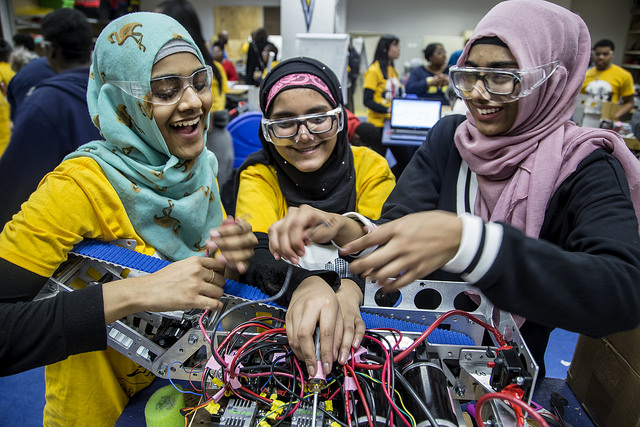 |
As the home of the American auto industry and birthplace of Motown, Detroit has always been a hub for American ingenuity and creativity. But in 2013, Detroit became the largest American city to declare bankruptcy after decades of economic. The city officially exited bankruptcy in 2014 following a debt restructuring plan, but many feel that the work to get the city back on track has just begun.
Still, the transformation that’s begun in the heart of downtown Detroit, which city leaders and residents are working to channel into the outer neighborhoods, signals hope. The residents of Detroit have worked hard to fight widespread economic hardships and earned their home the nickname “Renaissance City.”
What is catalyzing the economic revival of this city? Efforts like the University of Michigan’s Michigan Engineering Zone (MEZ) are definitely a helping hand in restarting the economic engine.
Founded in 2010, the Michigan Engineering Zone empowers children in Center City Detroit to follow careers in science, technology, engineeering, and math (STEM) and to pursue a college education. Serving a 95 percent African American student community, the program meets five days a week as they prepare to compete in the FIRST Robotics Competition. The University of Michigan provides students with the space, tools, and software. Students are led by engineering students from the University of Michigan, who are provided with transportation from the Ann Arbor campus to center city Detroit, courtesy of the university, during days of instruction.
United Detroit’s youth through robotics
The purpose of the program is to inspire students from the 18 participating schools to pursue a career in STEM. To draw all underrepresented students to the field of STEM, the university works with the highest- and lowest-performing schools in Detroit Public Schools.
The director of the program, Julian Pate, says that the labels of school prestige are left at the door. “A major goal here is to show students that people come from different backgrounds.”
Instead, students are encouraged to work together in a collaborative environment that prepares them for the real world. In fostering cooperation and team work, the program works to teach its students that “winning is just an activity, and not to spend their time chasing trophies. “
The MEZ provide more than just the tools needed to engineer a robot. Students and their parents are also introduced to what it means to be a college student. Many of these students are the first in their family to attend college, and having guidance and support from college graduates helps answer their questions and give them insight into the next step of their educational careers.
“We hold periodic sessions to solve the mystery of what college readiness looks like,” Mr. Pate says. These information sessions aim at involving parents in the college readiness process. The equation appears to be working: 62 of the last 65 graduating seniors who attended MEZ were accepted into the University of Michigan, while the other three enlisted in the military.
Achieving success through cooperation
Community efforts and partnerships are the lifeline inthis program. Monday through Thursday, Detroit Public Schools provide transportation to the MEZ center to ensure students can stay committed to the program. In addition, the Ford Foundation helps fund lunches provided during Saturday’s day long instruction. Other local organizations and corporate partners like Google have made contributions to the program, as well. Still, some obstacles keep the MEZ from reaching a wider range of students in need.
“The biggest obstacle is space,” says Mr. Pate. The University of Michigan has provided many resources to the program, but a wider space for work could allow more students to participate in the program. Already, others within the University have begun to find more space in the future. “The goal here is to find all the hidden gems in the city.”
According to Mr. Pate, the key for success of the program comes from a culture that is fostered from the top to the bottom. Program directors allow children to lead themselves, as opposed to having program leaders dictate what and how the children learn. This hands-off approach encourages students to take risks and experiment in an academic setting. By learning through trial by error, the participants of this program are empowered to try new ways to solve problems inside and outside of the classroom.
“This allows students to learn from their mistakes and feel engaged with a purpose,” says Mr. Pate.
To learn more about the Michigan Engineering Zone and how you can help the organization, click here.
Comments are closed.